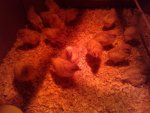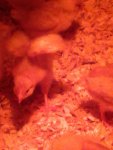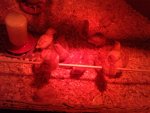They lay in the winter without supplemental lighting? Everything I've read is that hens need 12 to 14 hours or so of light to continue laying. Do you also use a heated warterer in winter or just bring out warm water a couple of times a day? My setup will be next to an existing storage shed so that protects from wind in the run from one direction and the coop will protect one of the ends of the run. Thinking about metal roofing I can lay on top of the run in winter to keep some snow out and wind and then maybe temporary panels for the other long side of the run so the run is protected on 3 sides. Open end of the run to the east to let some natural light in. Probably over thinking this but I blame the military training for contingency planning. Lol!
Truthfully... not well! They really DO need 14 hours of light, although the light levels don't have to be all that bright. Chicken feed used to be a metaphor for "cheap"... not any more! I can't afford to feed 2 dozen birds to get 3-4 eggs a day, when supplying a little supplemental light will give me 20 eggs a day. We have electricity in our pens, but if you don't, just get some solar powered WARM WHITE (NOT COOL/Blue!) LED lights, and set them up. Most have a light sensor so they turn on at dusk and off at dawn, and I've never had the slightest problem with the light staying on the entire night... my hens don't "burn out", die sooner, or any of the other old wives tales the "old fashioned" purists claim.
The LED lights are not bright, (in fact, I often have to walk out to the coop to see if they're on, when a 12 watt compact florescent in a ceiling fixture is easily seen from the house) but they work. They MUST be warm colored (yellow/orange) light, however... chickens absorb light through their skull into their pineal glands and blue light isn't absorbed!
A heated waterer makes things MUCH easier, but it's certainly possible to carry warm water out 2-3 times a day. As long as it keeps from freezing long enough for all the birds to get their thirst satiated, they'll be fine. Frozen eggs are a bigger problem, but if you gather eggs around the mid-day watering time (if that's possible... they normally *mostly* lay in the early to mid morning hours, although there are always a few exceptions), you shouldn't end up with too many cracked or split eggs.
The Black Stars, like all the Sex linked breeds, tend to be small birds. This is much more efficient for feed conversion ratios, but it's not ideal for really cold climates. However, we see 10 below zero in the winter on occasion (not weeks on end) and have never supplied a heat lamp... or needed one. We have had some frostbitten combs in the large, single combed breeds, and it affects male fertility until it heals, and probably also laying rates on the hens. This would be one good reason to consider looking for a rose combed breed, or at least not one of the Meditteranean breeds (they use their combs as "air conditioning"... the larger the comb surface area, the better they tolerate heat, as they are very vascular and release body heat into the air)
I loved my Buff Orpingtons, but found that for whatever reason, they had a stronger tendency to eat eggs than any other breed- and I've had *many* different breeds over 35 years. I tried Buffs three times, and finally gave up.
My current mix is Cuckoo Marans (heavy birds, which can double as a decent meat bird, and they lay extremely high quality eggs in heavy, dark cinnamon colored shells), Americaunas ("easter egg layers"), Slow White Broilers (a specialty breed from Welp Hatchery, and if I could only keep one breed, they would be it... they're second only to the CornishX birds for feed conversion to meat (reach 5# dressed weight 2-3 weeks later than the CornishX... any other heavy breed of chicken will take 6 months to get to that point). They lay earlier than any other breed I've tried, including Golden Comets and Leghorns. And they lay right through the winter, but tolerate heat well. Biggest drawback is probably that they're all white birds... and I'm not all that fond of white birds! But these are very pretty birds... sturdy, deep bodied, very attractive.
I also have some Whiting's True Blues I got from McMurray Hatchery last year. They are still laying amazingly well, and laid well all winter long- which surprised me, because they are TINY. I swear, the hens don't weigh any more than maybe 3 1/2 pounds! The eggs are a pale "Robin's Egg blue" color. Drawbacks are shell quality- it sucks. Too many broken eggs, especially for first year layers which have access to the same amount of oyster shell as all the other birds, whose shells are sturdy. And they are VERY flighty birds... not a major problem for us, as we don't make pets of ours or handle them much. But they aren't the friendly, curious type. However, the rooster has shown no aggression at all, although he is quite protective of his hens.
I've currently got 18 chicks started of the Blues, because I really do love the multi colored egg basket we get between the Americaunas, Blues, Marans, and Slow Whites (who lay a light brown egg). But if things were to go south, all but the Slow Whites and possibly the Americaunas (because they are very productive, laying large colored eggs through the winter, despite small body size) would be gone.
Summerthyme



